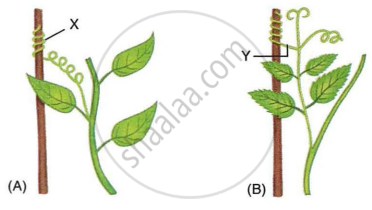Advertisements
Advertisements
प्रश्न
While conducting experiments to study the effect of various stimuli on the plants, it was observed that the roots of a plant X grow and bend towards two stimuli A and B but bend away from a third stimulus C. The stem of the plant X, however, bends away from stimuli A and B but bends towards the stimulus C. The stimulus B is known to act on the roots due to too much weight of the earth. Keeping these points in mind, answer the following question:
- What could stimulus A be?
- Name the stimulus B.
- What could stimulus C be?
- The branches of a fallen tree in a forest grow straight up in response to two stimuli. What could be these two stimuli out of A, B and C? Also name these two stimuli.
उत्तर
- The stimulus A is water.
- The stimulus B is gravity.
- The stimulus C is light.
- The two stimuli responsible for the straight growth of the branches of a fallen tree are B and C, i.e., gravity and light, respectively.
APPEARS IN
संबंधित प्रश्न
How do auxins promote the growth of a tendril around a support?
What is a plant hormone? Name four plant hormones. State one function of each.
What is meant by nastic movements in plants? Give one example of nastic movements in plants.
Why is the closing of a dandelion flower at dusk (when it gets dark) not a tropism?
Define phototropism. Give one example of phototropism.
A potted plant is growing in a transparent glass jar. In this plant, X and Y are the two growing parts having a lot of meristematic tissue. It is observed that the part X of this plant exhibits positive geotropism but negative phototropism. On the other hand, part Y of this plant exhibits negative geotropism but positive phototropism.
(a) Name the part X of plant.
(b) Name the part Y of plant.
(c) Which part of the plant, X or Y, will exhibit positive hydrotropism?
(d) Which part of the plant, X or Y, can have tendrils on it?
(e) Which phytohormone causes the part X to exhibit negative phototropism?
When the leaves of a sensitive plant are touched with a finger, they fold up and when light fades at dusk, the petals of a dandelion flower close.
State one way in which the above two processes are similar.
Observe the three figures given below. Which of the following depicts tropic movements appropriately?
 |
 |
 |
| A | B | C |
Name a plant hormone responsible for bending of a shoot of a plant when it is exposed to unidirectional light. How does is promote phototropism?
Study the diagrams given below and answer the following questions:

- Name the structures shown as X and Y in the figures (A) and (B), respectively.
- Write the functions performed by the structures X and Y.
- Name the phenomenon depicted and define it.
- How do the structures X and Y differ from each other?
- Give examples of the plants which show the said phenomenon.
